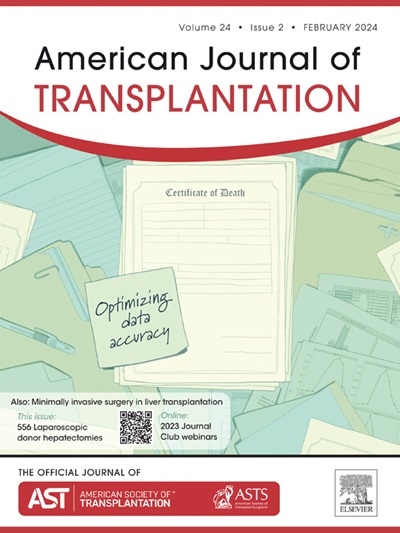严重再生障碍性贫血患者的肾移植:4例患者耐受或血液恢复的病例系列。
IF 8.2
2区 医学
Q1 SURGERY
引用次数: 0
摘要
严重再生障碍性贫血(SAA)是一种以全血细胞减少和骨髓细胞减少为特征的骨髓衰竭综合征。当伴有终末期肾病(ESKD)时,它提出了一个重大的治疗挑战。虽然同种异体造血干细胞移植(HSCT)是SAA的最终治疗方法,肾移植(KT)是ESKD的最佳治疗方法,但执行这两种手术的理想测序和策略尚不清楚。我们报告了4例同时患有SAA和ESKD的患者使用KT-first方法治疗的成功结果。所有患者均表现出立即移植功能,无手术并发症,移植后一年内未发生急性排斥反应。两名患者随后在KT后大约三个月接受了来自同一供体的HSCT。两人都获得了血液学缓解,并最终能够停止所有免疫抑制药物。值得注意的是,另外两名患者经历了自发的血液学改善,不再需要造血干细胞移植。这些研究结果表明,KT-first方法既可行又安全,不仅可以作为治疗性HSCT的桥梁,而且在某些情况下,可以作为SAA的潜在独立治疗方法。该病例系列提供了支持kt优先策略在并发SAA和ESKD患者中的作用的初步证据。本文章由计算机程序翻译,如有差异,请以英文原文为准。
Kidney Transplantation in Patients with Severe Aplastic Anemia: A Case Series of Four Patients Bridging to Tolerance or Hematologic Recovery.
Severe aplastic anemia (SAA) is a bone marrow failure syndrome characterized by pancytopenia and hypocellular marrow. When accompanied by end-stage kidney disease (ESKD), it presents a significant therapeutic challenge. While allogeneic hematopoietic stem cell transplantation (HSCT) is the definitive treatment for SAA and kidney transplantation (KT) is the optimal therapy for ESKD, the ideal sequencing and strategy for performing both procedures remain unclear. We report successful outcomes in four patients with concurrent SAA and ESKD managed using a KT-first approach. All patients demonstrated immediate graft function without surgical complications, and no episodes of acute rejection were observed within the first year post-transplant. Two patients subsequently underwent HSCT from the same donor used for KT, approximately three months after KT. Both achieved hematologic remission and were eventually able to discontinue all immunosuppressive medications. Remarkably, the other two patients experienced spontaneous hematologic improvement and no longer required HSCT. These findings suggest that the KT-first approach is both feasible and safe, serving not only as a bridge to curative HSCT but also, in select cases, as a potential standalone therapy for SAA. This case series provides preliminary evidence supporting the role of the KT-first strategy in patients with coexisting SAA and ESKD.
求助全文
通过发布文献求助,成功后即可免费获取论文全文。
去求助
来源期刊
CiteScore
18.70
自引率
4.50%
发文量
346
审稿时长
26 days
期刊介绍:
The American Journal of Transplantation is a leading journal in the field of transplantation. It serves as a forum for debate and reassessment, an agent of change, and a major platform for promoting understanding, improving results, and advancing science. Published monthly, it provides an essential resource for researchers and clinicians worldwide.
The journal publishes original articles, case reports, invited reviews, letters to the editor, critical reviews, news features, consensus documents, and guidelines over 12 issues a year. It covers all major subject areas in transplantation, including thoracic (heart, lung), abdominal (kidney, liver, pancreas, islets), tissue and stem cell transplantation, organ and tissue donation and preservation, tissue injury, repair, inflammation, and aging, histocompatibility, drugs and pharmacology, graft survival, and prevention of graft dysfunction and failure. It also explores ethical and social issues in the field.

 求助内容:
求助内容: 应助结果提醒方式:
应助结果提醒方式:


